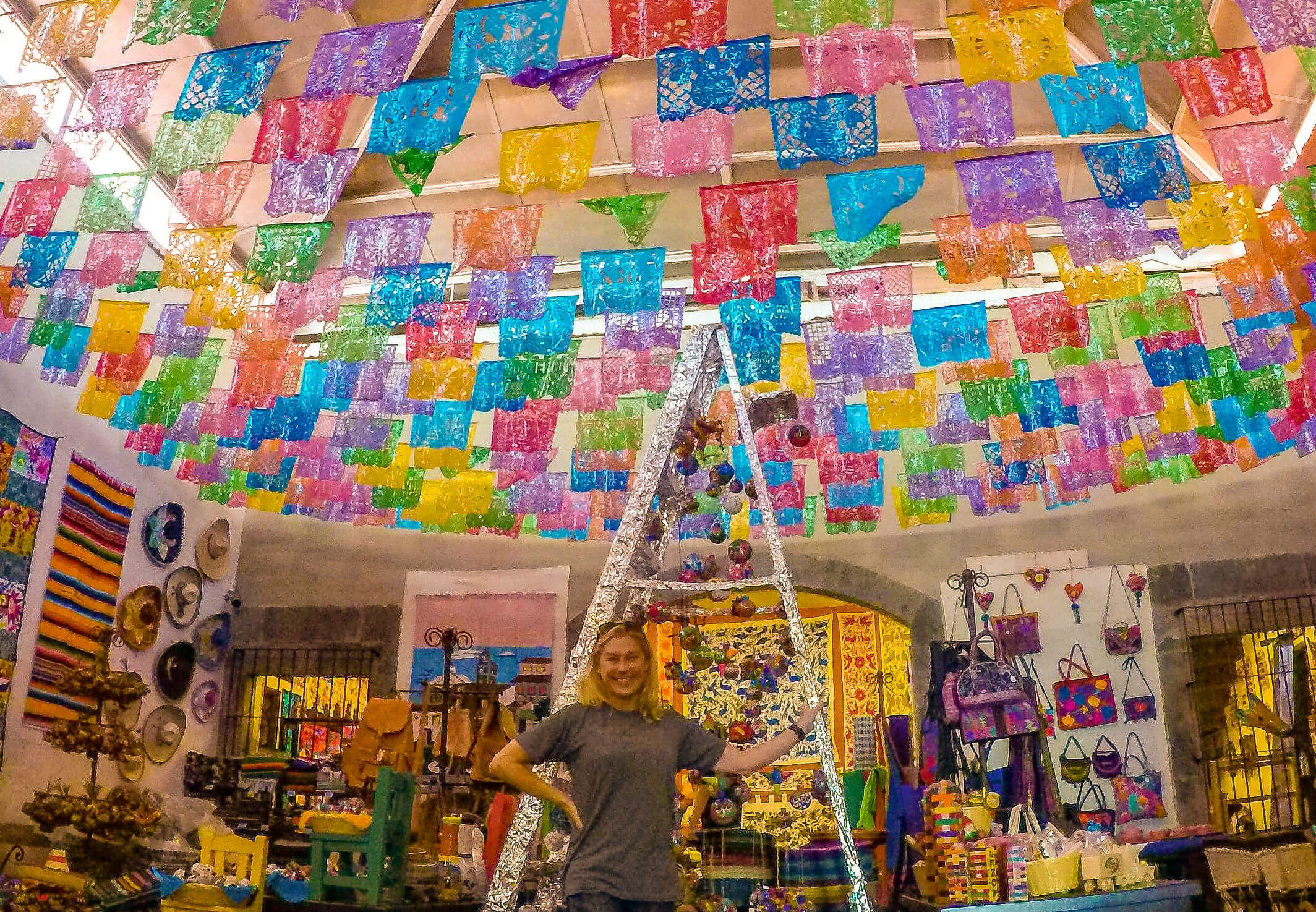
So you’ve seen the movie “Coco” from Pixar, right? Aren’t the scenes of Miguel’s village and then the Xanadu afterlife city the most visually stunning destinations you have ever seen? Me too!
You may or may not have noticed that a majority of the color you see in every scene is due to the placement of those colorful banners that wave all over both magical places.
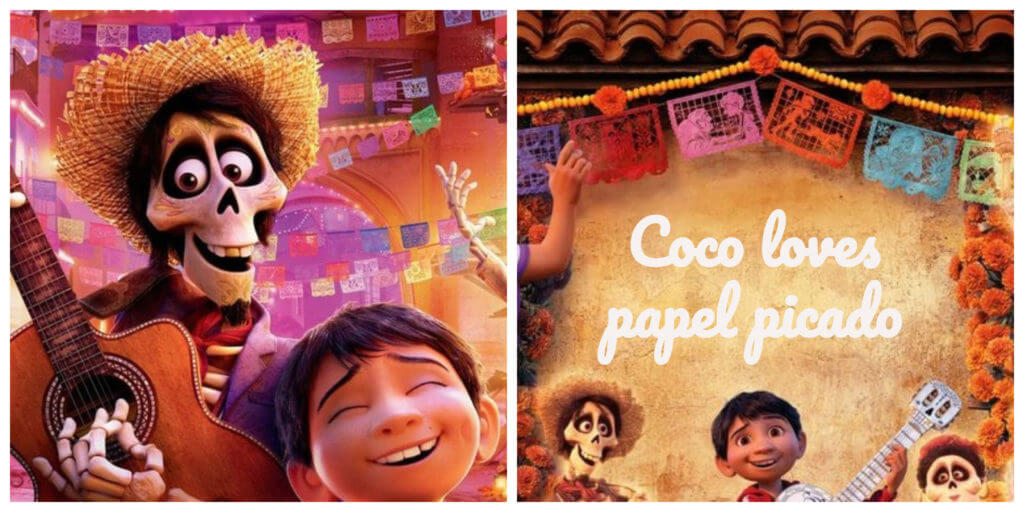
Welp, actually México is just like that. Color pouring from the sky everywhere.
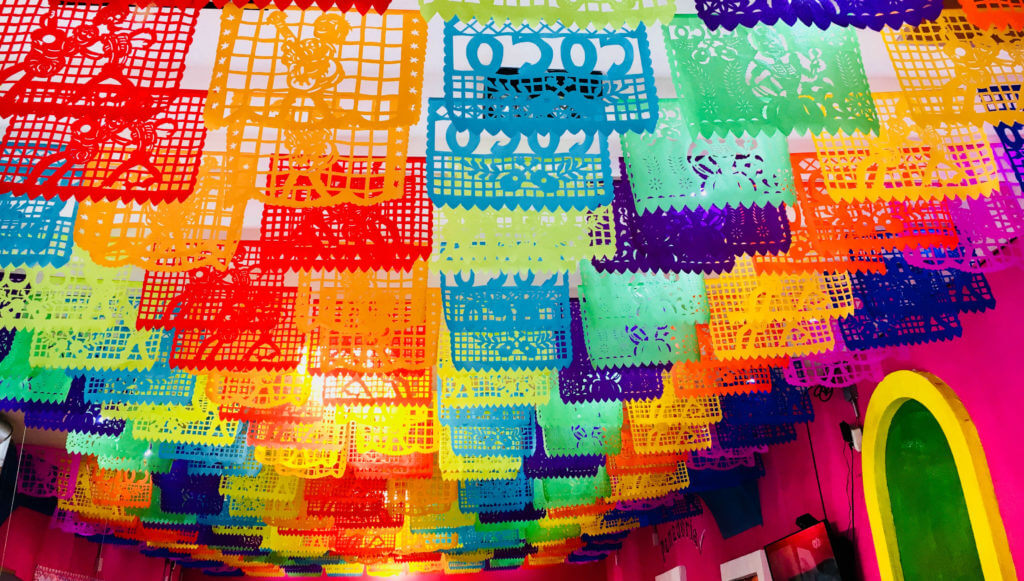
My hunt for these magical, colorful Papel Picado flags has taken me from enormous Mexican mercados to tiny little villages and what I’ve found is not only excellent products to export to the US and Europe, but also a tradition steeped in history and artistry, one precise hammer stroke at a time.
Here is the play by play of my quest for the birthplace of Papel Picado and the man with original birthrights to make it, otherwise known as the ‘Robin Hood’ of his town…
One year ago, I was in search of a pueblo called San Salvador Huixcolotla, which is known as the “Cradle of Punched Paper” and is the birthplace of Papel Picado flags. These colorful banners have been a part of every Mexican celebration for decades and are a symbol of México’s handmade craftsmanship at its finest.
Any birthday party, wedding or holiday gathering in México doesn’t get started until the Papel Picado is carefully strung from the rafters and roofs to welcome the party goers and to warn the neighbors that shit is about to get cray cray.
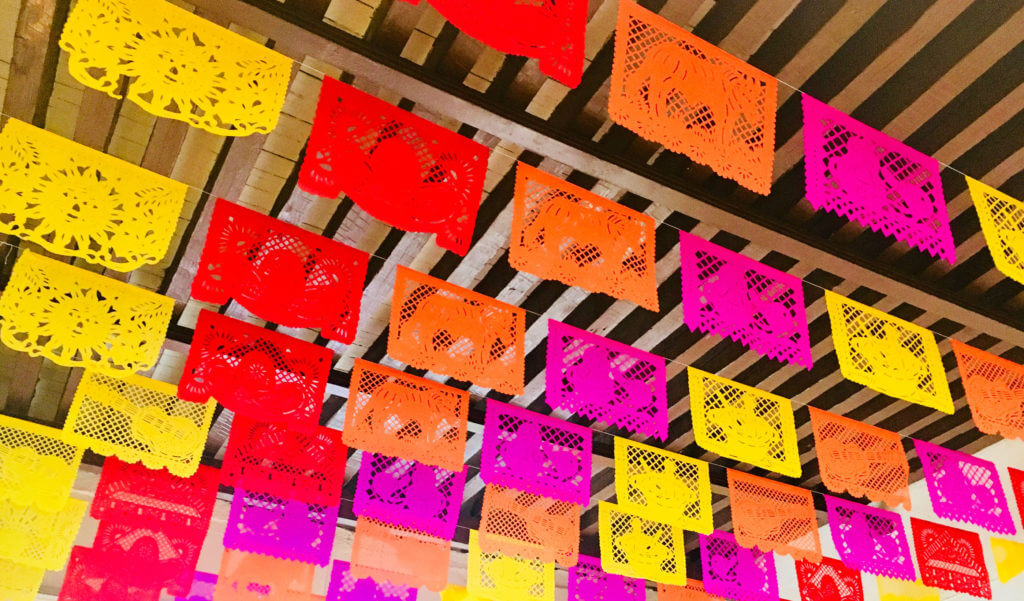
My Story:
I found myself driving on a razor thin 2-lane road somewhere in the State of Puebla in Central México when I see in the distance a man standing in the middle of the broken pavement frantically waving a red bandana above his head. To my left was the majestic ice capped Orizaba Volcano, to my right were 3 dogs running beside my car and in front of me I had no idea, so I slowed.
The man strategically positioned in the middle of the road was actually directing traffic over a shitty one-lane bridge that I was about to cross. Evidently, when the state government of Puebla made this road they didn’t think it was important enough to spend the money on a two lane bridge. Why would they?
This bandana-waving fella’s job was to stop cars on one side of the bridge to allow cars coming from the other side to pass. I tipped him a few pesos for helping me avoid a head-on collision and was over the bridge and on my way to the worldwide mecca of Papel Picado. Yay!!
I had found the heartbeat of Papel Picado, now I was off to find Robin Hood.
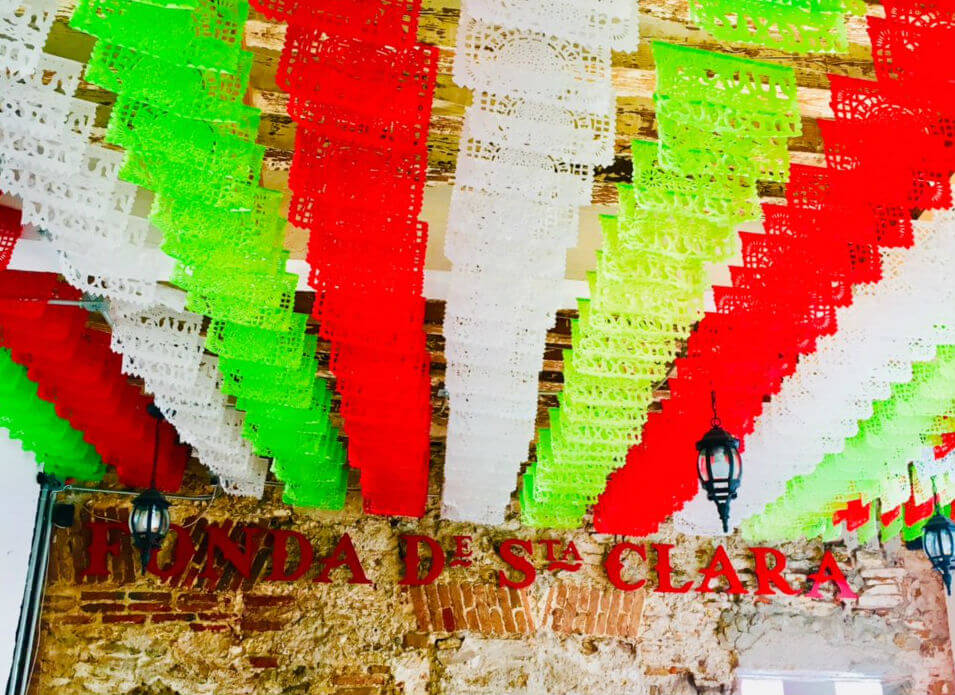
That sounded dramatic, right?! OK, truth be told, I already knew who he was. We had met several times at conventions in Guadalajara and now WhatsApp pretty frequently regarding my orders and re-orders, but I had no idea at this moment in time that my mind was about to get blown.
Stories sound better when there is more mysticism and general awe-factor, don’t you think? Anyhoo, we’ll just call our Robin Hood friend, “Max”.
Max insisted on meeting me at the outskirts of his village at a point immediately after the scary-ass mini-bridge so that I could follow him in his unnecessarily large truck to his “taller” (workshop). The whole point of following him versus just giving me directions or dropping a location pin (nope, Google Maps and Waze haven’t figured this area out yet) is because there are no street signs. At all. In the entire village.
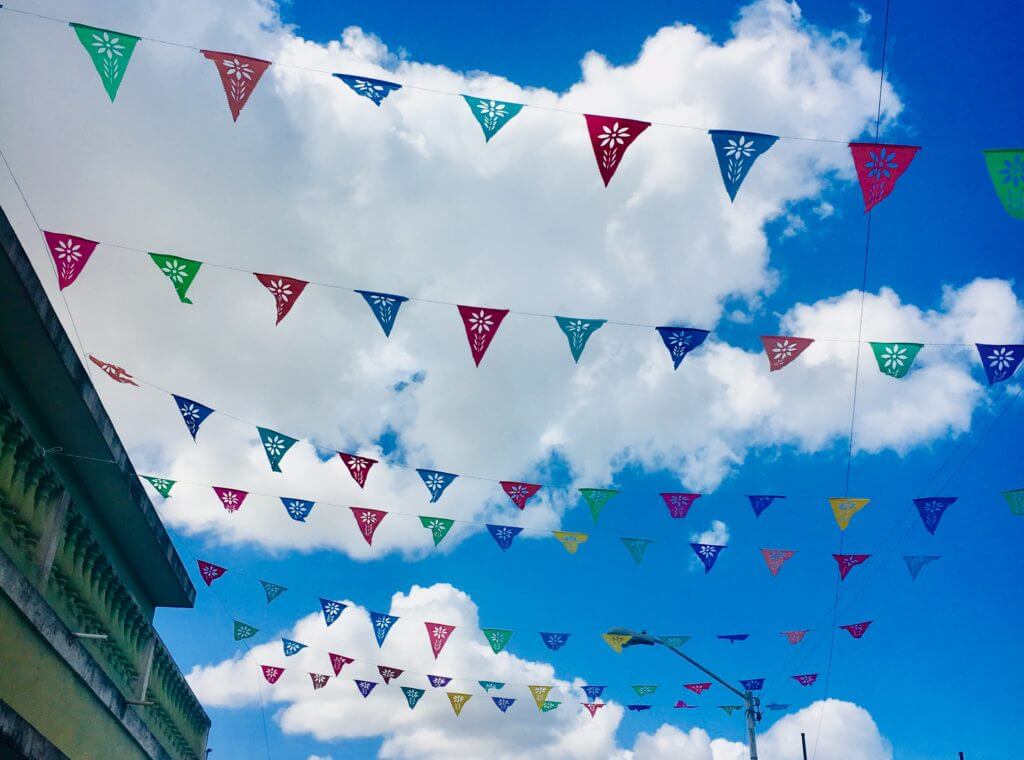
Once I entered San Salvador Huixcolotla, it was clear that this was indeed the epicenter of these magical banners. Everywhere I turned, I was shaded by fluttering clouds of color.
Every street was magically draped with these intricate banners depicting all aspects of Mexican life ranging from Dia de Los Muertos to the Virgin of Guadalupe. Basically, like the Xanadu afterlife city in “Coco”.
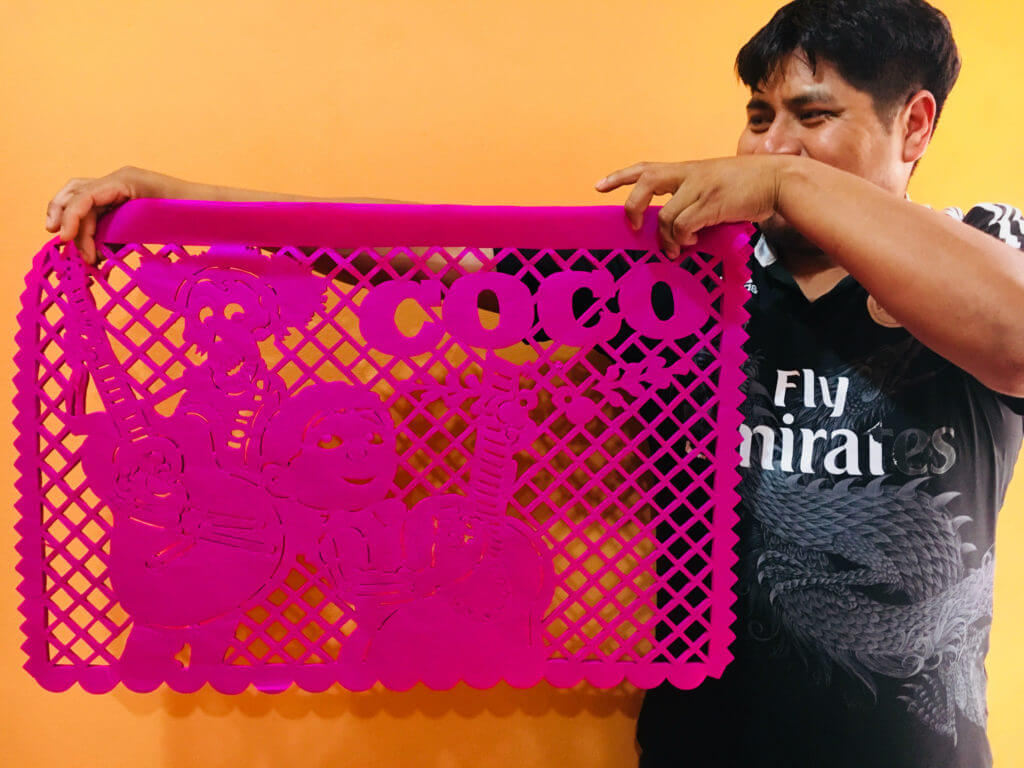
Actual History:
By the way, according to Wikipedia…The Ministry of Tourism and Culture in Mexico officially recognizes and supports the art of Papel Picado. And in 1998, the governor of the state of Puebla decreed that the style of Papel Picado produced in San Salvador Huixcolota is part of the ‘Cultural Heritage of the State of Puebla’ (Patrimonio Cultural del Estado de Puebla). How ’bout that!?!
?? Shop the TexMex Fun Stuff online storefront on Amazon! ??
I followed Max in my Nissan Murano, which thank God has kick ass shocks, all the way to Max’s taller. His workshop is in the middle of town in a compound which includes his home (which he shares with his wife and son) and other buildings, bodegas and houses in which his brothers, cousins, nephews, nieces/employees also live and work. Chickens, dogs, kids and a cat run around this compound constantly.
I don’t know how any work gets done, but delicious chicken mole and beautiful Papel Picado are made here. If you ever get the chance to taste Max’s wife’s homemade mole – you should really go for it. I digress.
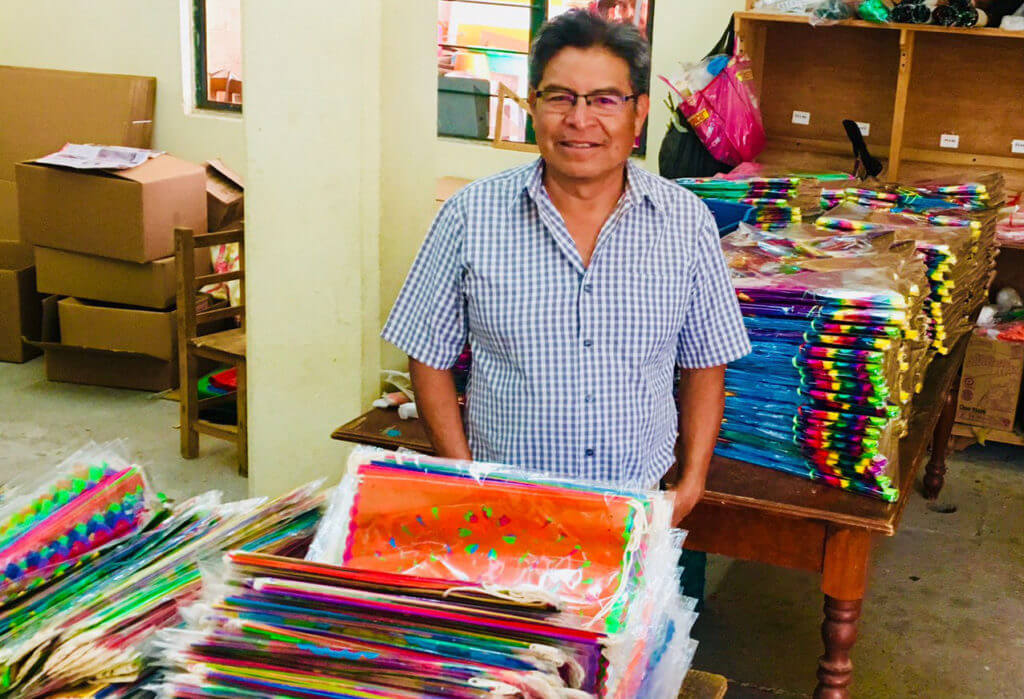
So anyway, Max is showing me around and introducing me to his family/employees and he casually mentions that his great-grandfather is the originator of Mexican Papel Picado. Max speaks no English and my Spanish is barely passable, but I got the jist…His great grandfather was Aztec and Spanish, but he learned this craft from a Chinese friend. Chinese invented super fine paper. They are especially known for creating “Chinese Paper” or as we call it in North America, tissue paper.
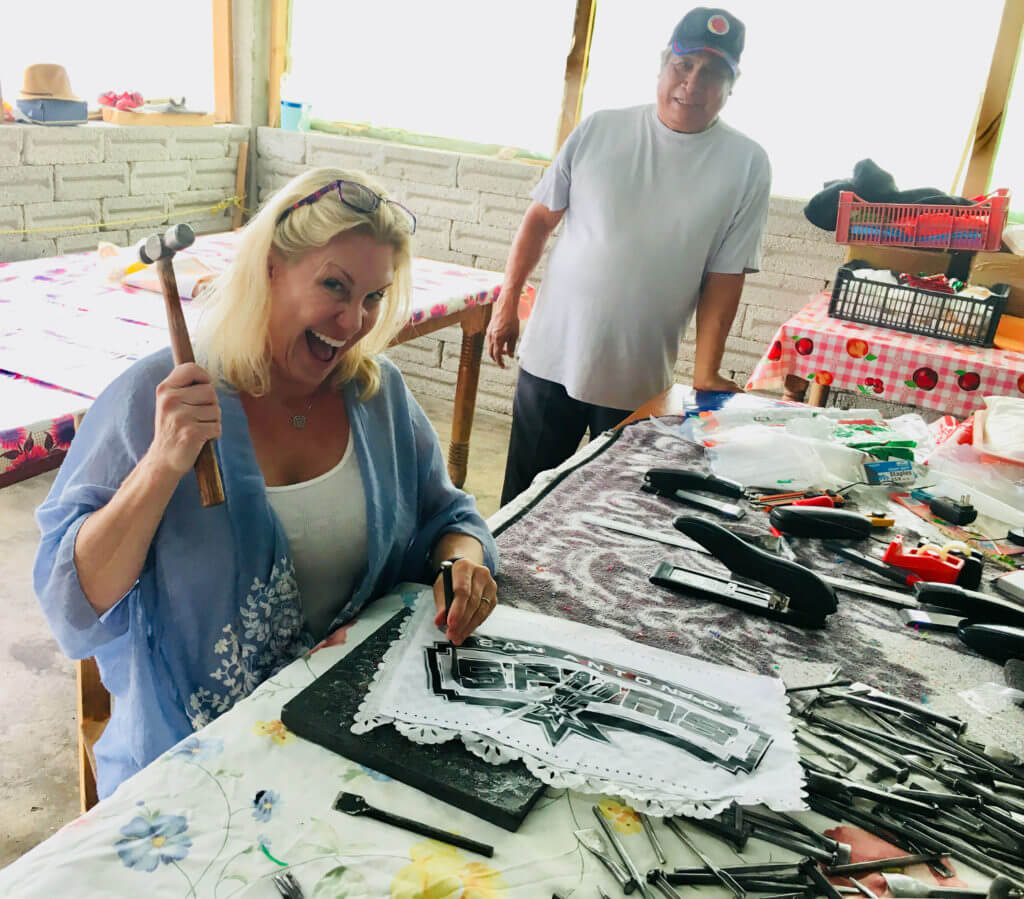
Welp, Papel Picado is basically perforated tissue paper. The designs are commonly cut into colored tissue paper using a stencil or template and small mallets or chisels. Depending on the fold of the paper and the skill level of the chiseler, as many as fifty banners can be created at a time. Check out this video to see what I mean…
Evidently local hacienda owners would import this paper from China and sell it at their hacienda stores – this Chinese friend bought some and showed Max’s great granddad how the Chinese make cutouts and use the designed paper as flags to decorate homes or towns for parties and festivals.
Well great-grandad thought, “Mexicans love parties and festivals…this could work!”
?? Shop for Papel Picado on Amazon ??
As many traditions continue through generations of families, Max’s grandfather and father learned the trade and eventually Max was trained and inherited the family company. He employs all of his extended family and most of the town.
The bigger an order he receives, the more neighbors he contracts to get the job done. He says that in the 4th quarter of every year, the entire town is working for him in some capacity, hence the Robin Hood legacy. He is San Salvador Huixcolota’s biggest employer.
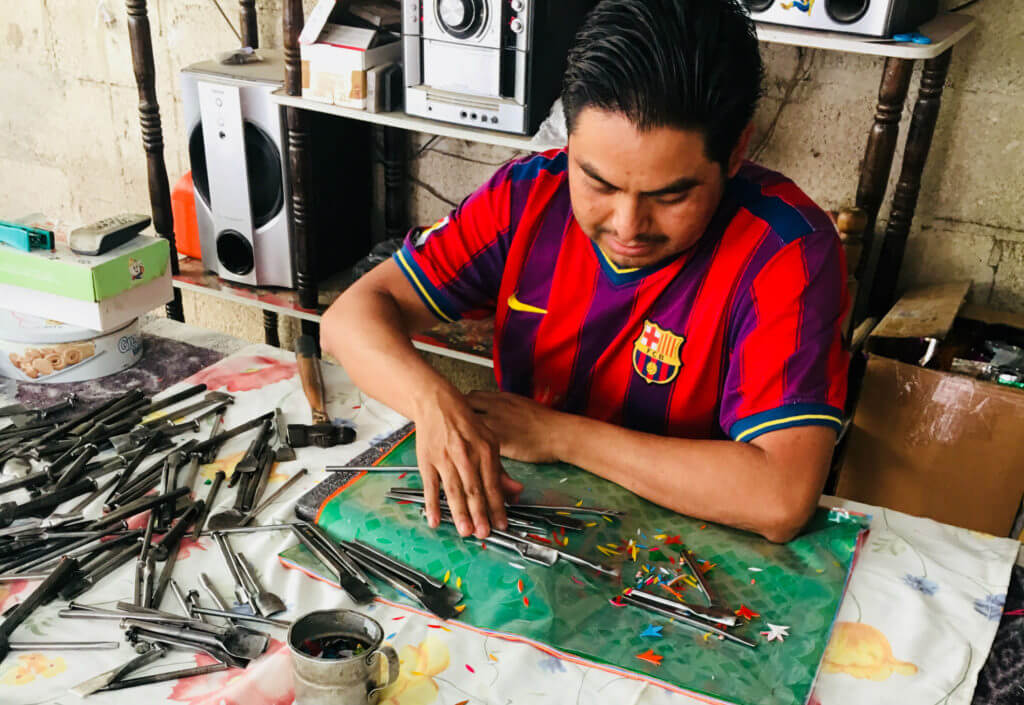
Every day, he and his brother drive the completed work of the day before into the city of Puebla to ship off the goods. One hour in each direction and 2 tips for the bandana bridge guy. Every day.
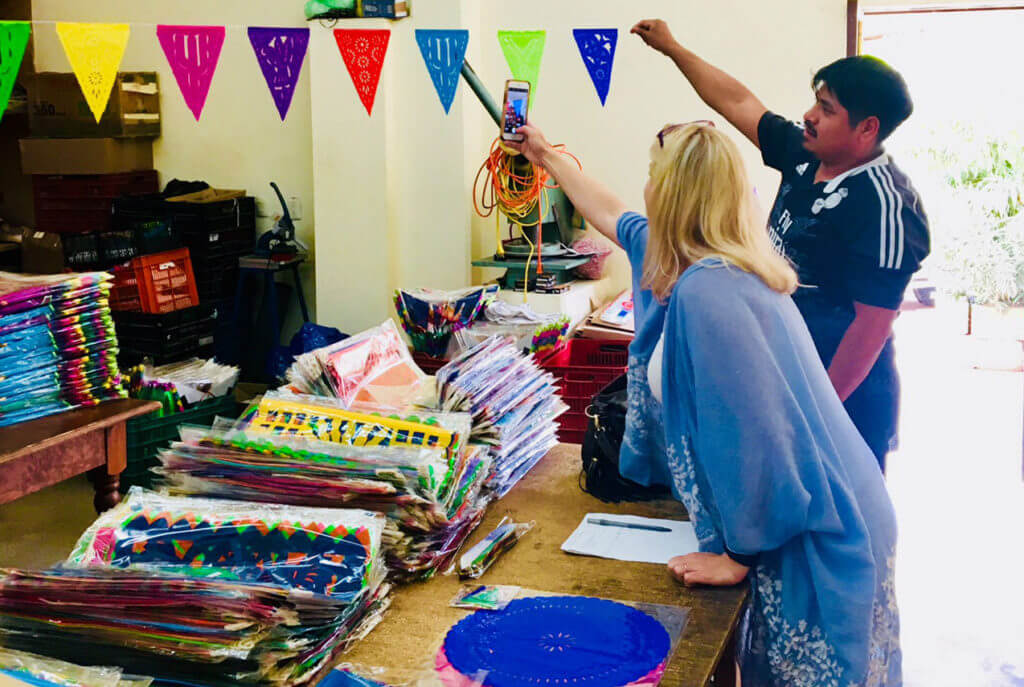
Max tells me that tissue paper banners are the best sellers of his banner catalog, but plastic is growing in popularity as outdoor fiestas are quite popular too.
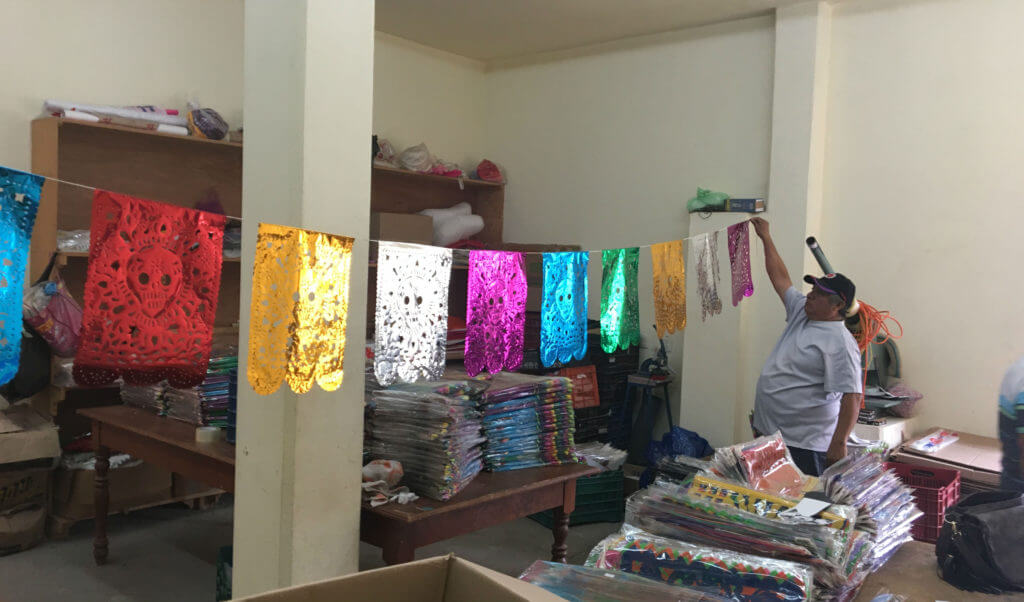
A few years ago he also started using mylar for a foil-like effect for customers who wanted banners with shine. Obviously plastic and mylar are more durable than the delicate tissue paper counterparts, but Max’s fam prefers to work with the traditional paper. Old dogs, new tricks.
So after 3 hours of demonstrating, picture taking and mole eating it was time to get out of San Sal. I placed a huge order, paid Max in cash for the goods I was taking back to Puebla with me and hit the road. Following Max in his unnecessarily large truck of course, because when there are no street signs AND its dark, navigation gets tricky. Luckily, the bandana guy was still on the tiny bridge and he waved me back to town. That was worth the $3 USD tip!
Experience México every day with this Coco Inspired Papel Picado! Buy Yours Here.
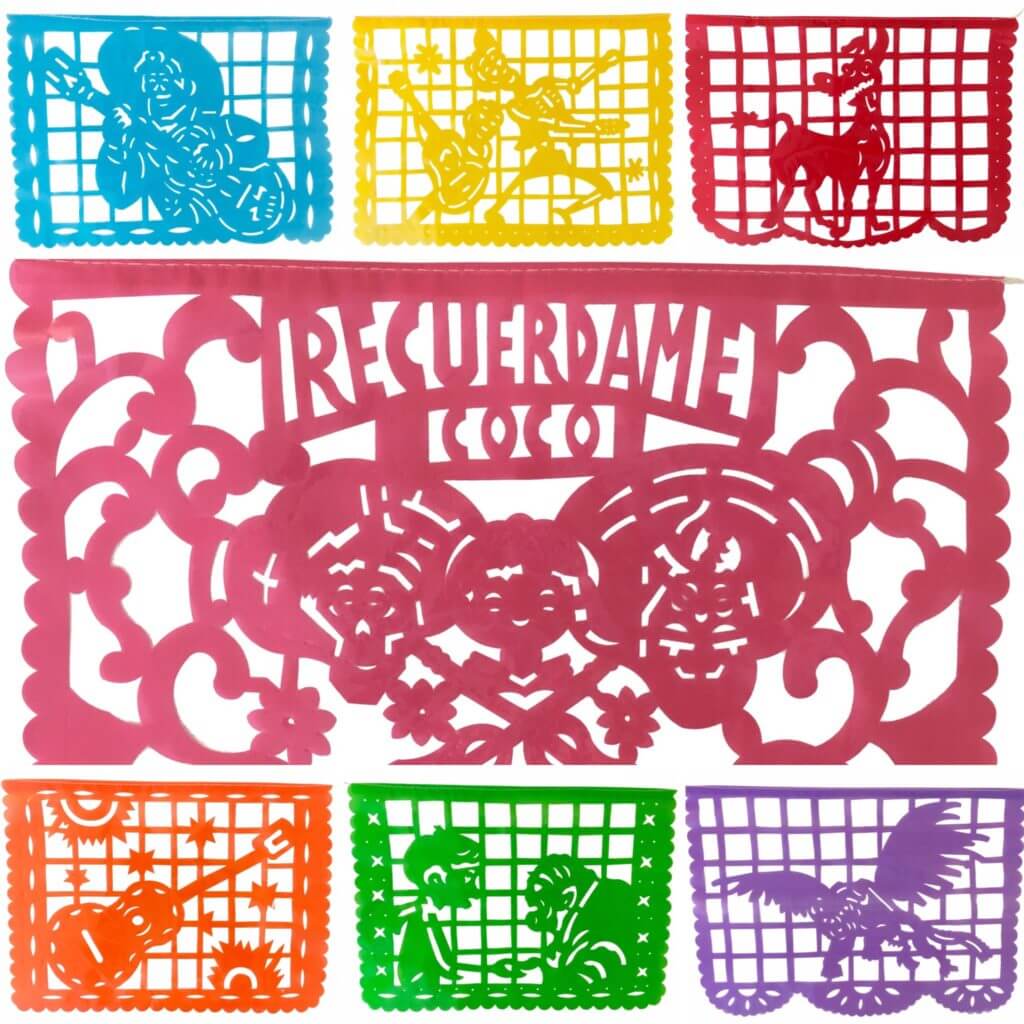
Shop the TexMex Fun Stuff Papel Picado Collection
Are you looking for more inspiration from México? Check out the TexMex Fun Stuff Blog for more sights, sounds and badass-ness uncovered while exploring México searching for handmade fun stuff for you!
Related Posts
5 Fun Historical Stories About Piñatas
My Lucha Libre Experience – Laughing, Crying and Screaming
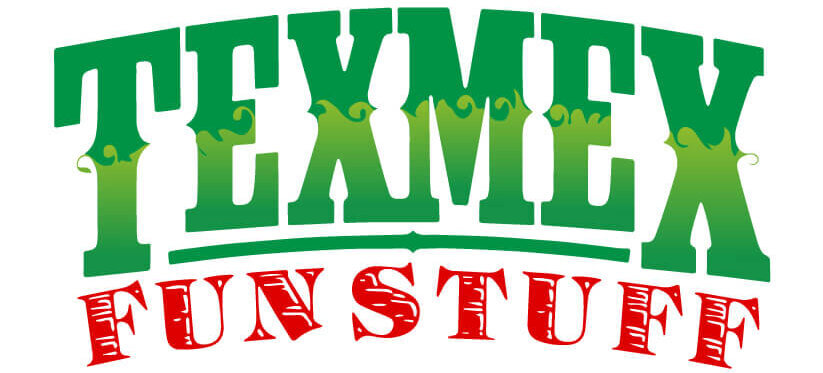
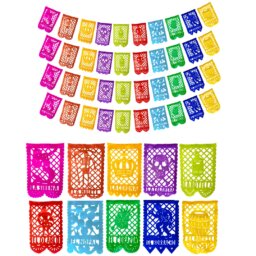
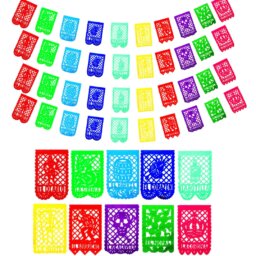
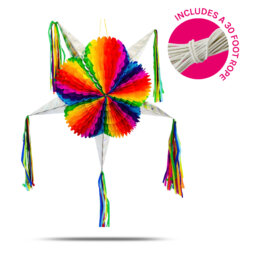
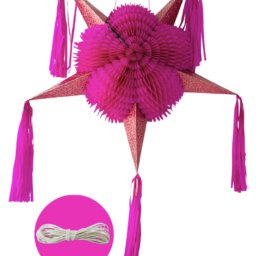
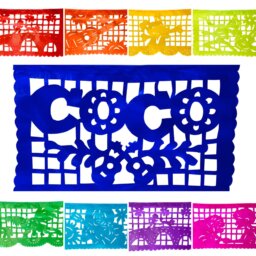
Hi there! Such a wonderful post, thank you!
Gracias and thanks to you!!
Could you tell me what theme are you utilizing on your site?
It looks nice.
Thank you! I believe it’s Storefront.
I’m sorry, it’s called Stationery.
This was a good read but I don’t understand why you choose to omit the artists name and discredit his family name by calling him Max. It didn’t add any mysticism It just makes it sound like the artist is not valued enough by you to even have a name. Credit-less anonymity gave less value to such a good story otherwise.
Hola Alejandra! Max asked me to not mention his family name so I respected his wishes.